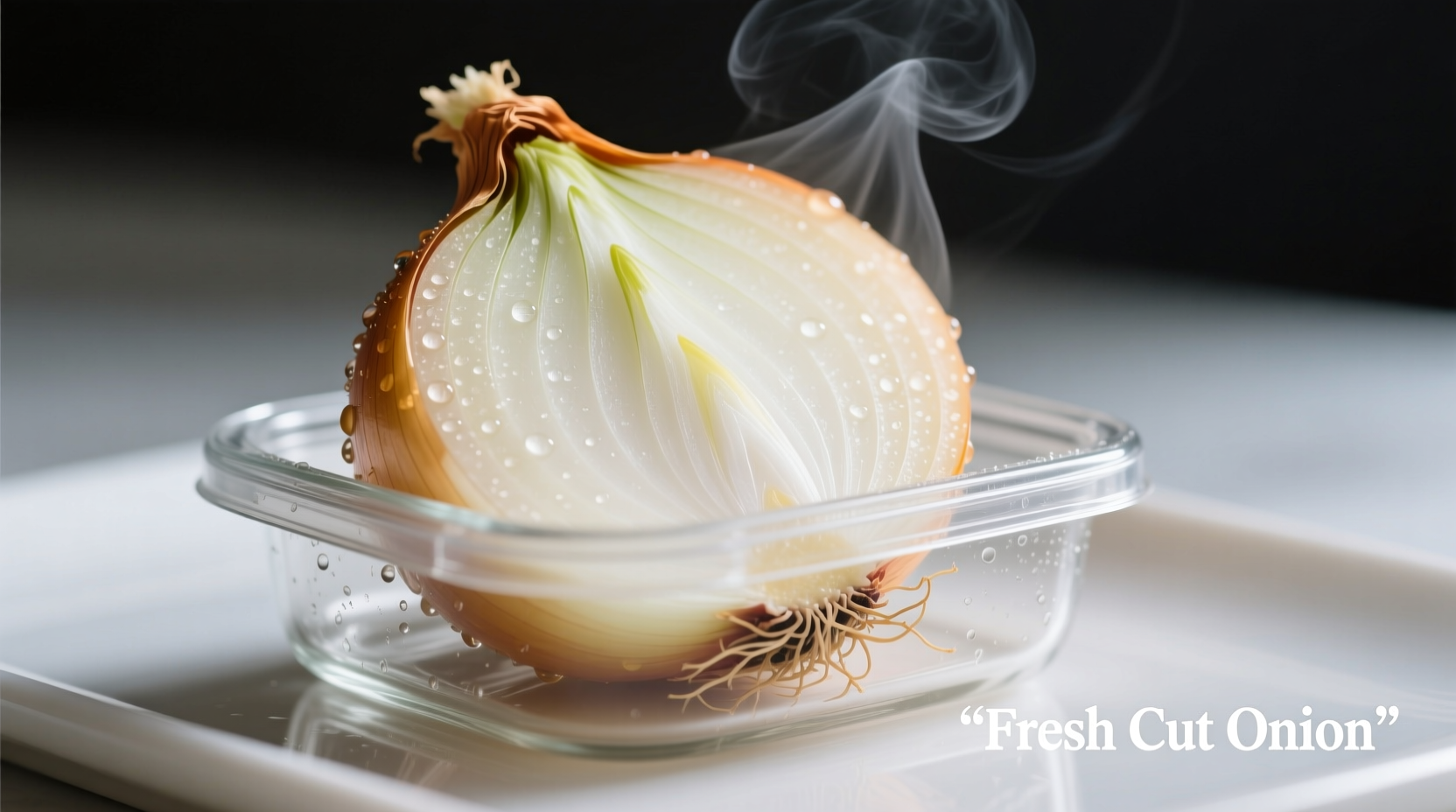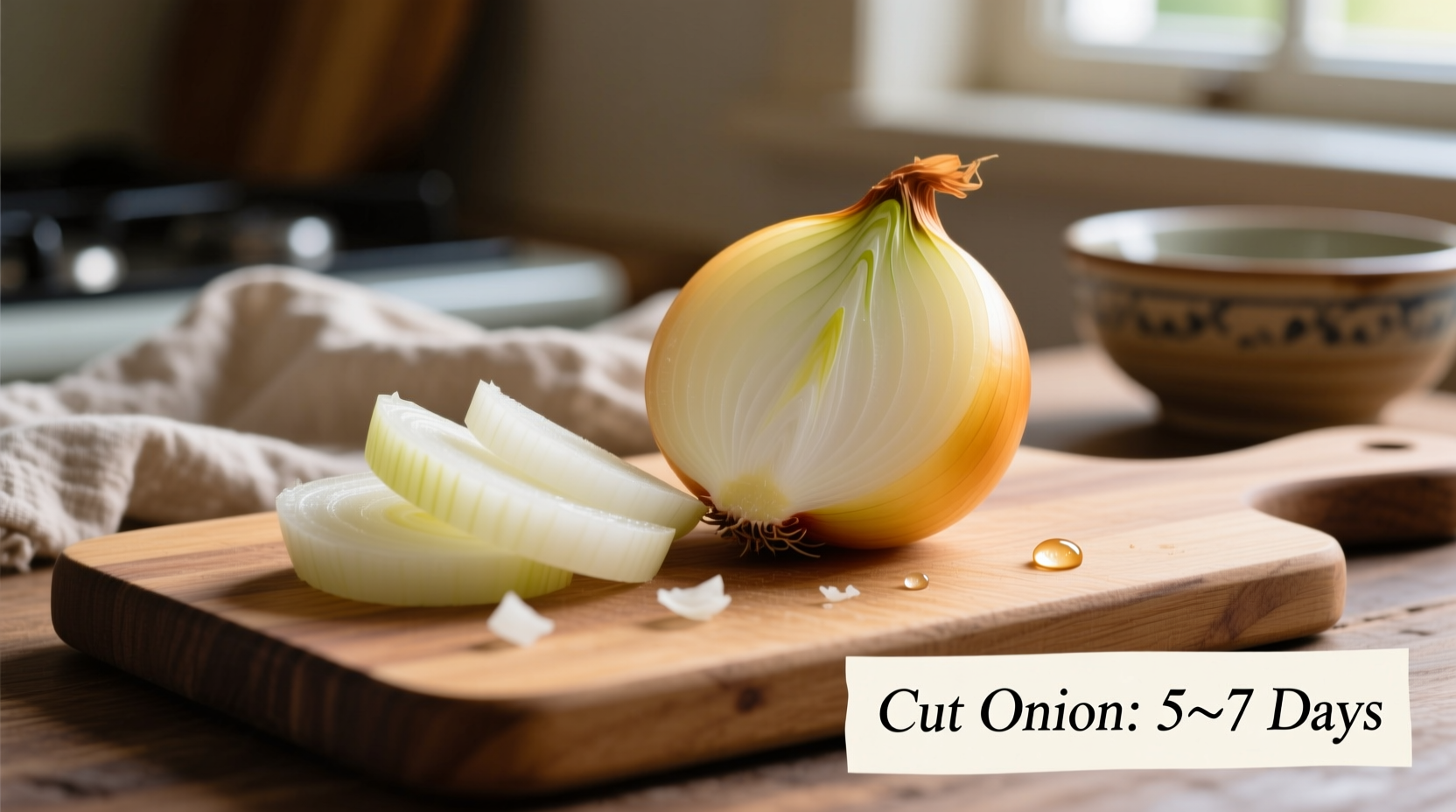Cut onions stay fresh for 7-10 days when properly stored in an airtight container in the refrigerator at or below 40°F (4°C). Room temperature storage reduces shelf life to just 2 hours before food safety risks increase significantly.
Ever chop an onion for a recipe, only to wonder how long you can safely keep the leftovers? You're not alone. Millions of home cooks face this exact question weekly, trying to balance food safety with reducing kitchen waste. Getting this right matters more than you might think—improperly stored cut onions can harbor bacteria that cause foodborne illness while perfectly good onions often get tossed unnecessarily.
Why Proper Onion Storage Matters for Your Health
Unlike whole onions with their protective papery skin, cut onions expose moist flesh that creates an ideal environment for bacterial growth. The USDA Food Safety and Inspection Service emphasizes that cut produce enters the "temperature danger zone" above 40°F, where pathogens multiply rapidly. This isn't just theoretical—onions have been implicated in several documented foodborne illness outbreaks when stored incorrectly.

Your Step-by-Step Guide to Maximizing Cut Onion Freshness
Follow these professional kitchen-tested methods to safely extend your cut onions' shelf life:
Immediate Post-Cutting Protocol
The first 30 minutes after cutting determine your onion's entire storage trajectory. Chefs recommend:
- Chill quickly: Transfer cut onions to refrigerator within 15 minutes
- Dry thoroughly: Pat with clean paper towels to remove surface moisture
- Air-tight is non-negotiable: Use containers with locking lids, not loosely covered bowls
Storage Method Comparison: What Actually Works
| Storage Method | Expected Shelf Life | Quality Preservation | Food Safety Risk |
|---|---|---|---|
| Airtight container in main fridge compartment | 7-10 days | Excellent | Low |
| Plastic wrap directly on onion surface | 3-5 days | Good | Moderate |
| Open container in refrigerator | 2-3 days | Poor | High |
| Room temperature (any method) | 2 hours max | Very poor | Very high |
Critical Factors That Shorten Your Cut Onion's Lifespan
Not all cut onions share the same shelf life. These often-overlooked factors dramatically impact freshness duration:
Temperature Consistency Matters More Than You Think
University of Minnesota Extension research shows that even brief temperature fluctuations above 40°F accelerate spoilage. Every time you take the container out for "just a quick use," you're resetting the bacterial growth clock. Their studies demonstrate that onions exposed to room temperature for cumulative periods exceeding 30 minutes lose 2 full days of potential refrigerator shelf life.
The Hidden Danger of Cross-Contamination
If you've mixed your cut onions with other ingredients (especially high-moisture foods like tomatoes), the clock starts ticking faster. The FDA Food Code specifies that combination preparations containing cut onions must be consumed within 7 days regardless of individual ingredient shelf lives. This strict guideline exists because onions' sugar content feeds bacterial growth when combined with other produce.
How to Spot Spoiled Onions Before They Make You Sick
Don't rely solely on calendar dates—your senses provide the most reliable spoilage indicators. Watch for these progressive warning signs:
- Day 1-3: Slight darkening at cut edges (normal, still safe)
- Day 4-6: Whitish film developing on surface (early spoilage)
- Day 7+: Slimy texture, strong sour odor, or visible mold (immediate discard)
The National Onion Association confirms that any sliminess means the onion has entered unsafe territory—bacteria have already multiplied to potentially dangerous levels. When in doubt, throw it out. No recipe is worth risking food poisoning.
Pro Tips for Extending Your Cut Onion's Usable Life
Professional kitchens use these science-backed methods to maximize onion freshness:
- Vacuum sealing: Removes oxygen that accelerates spoilage (adds 3-4 extra days)
- Citrus barrier: A light toss with lemon juice creates an acidic environment hostile to bacteria
- Freezing for cooking: Portion chopped onions in ice cube trays with water for ready-to-use cooking portions (keeps 6 months)
Remember that frozen onions work perfectly for cooked dishes but lose crispness for raw applications. The USDA confirms that frozen cut onions maintain safety indefinitely at 0°F, though quality peaks within 6 months.
Special Considerations for Different Onion Types
Not all onions behave the same after cutting. Sweet varieties like Vidalias contain more moisture and spoil faster than pungent yellow onions. According to Cornell University's food science department, sweet onions last 2-3 days less than storage onions under identical conditions due to their higher sugar and water content. Always prioritize using sweet onion leftovers first.
Putting It All Together: Your Cut Onion Timeline
Here's exactly what to do at each stage to maximize safety and freshness:
| 0-15 minutes after cutting | Dry thoroughly, transfer to airtight container, label with date |
| Day 1-3 | Optimal freshness for raw applications (salsas, salads) |
| Day 4-7 | Ideal for cooked dishes (soups, stews,炒菜) |
| Day 8-10 | Final safety window—inspect carefully before use |
When to Definitely Throw Out Cut Onions
Follow these non-negotiable discard rules from FoodSafety.gov:
- Left at room temperature longer than 2 hours (1 hour if kitchen exceeds 90°F)
- Develops any slimy texture or unpleasant odor
- Shows visible mold (even in one section—don't try to cut away)
- Exceeds 10 days in refrigerator regardless of appearance
Remember that onion spoilage isn't always visible—harmful bacteria like Salmonella can grow without obvious signs. When storage conditions were less than ideal, err on the side of caution.
Can I freeze cut onions for later use?
Yes, freezing is excellent for cooked applications. Spread chopped onions in a single layer on a baking sheet, freeze solid, then transfer to airtight containers. Frozen onions maintain quality for 6-8 months and can be added directly to cooked dishes without thawing. Note they'll lose crispness but retain flavor.
Why do cut onions go bad faster than whole onions?
Whole onions have a protective papery skin that creates a natural barrier against moisture loss and bacterial entry. Cutting removes this protection, exposing the moist interior where bacteria thrive. The increased surface area also accelerates enzymatic browning and moisture evaporation.
Does storing cut onions in water extend their freshness?
No, water storage actually shortens shelf life. While submerging cut onions in water might preserve crispness temporarily, it creates an ideal environment for bacterial growth and causes flavor compounds to leach out. The USDA recommends against water storage for cut produce due to increased food safety risks.
Can I still use cut onions that have turned slightly pink?
Pink discoloration in cut onions usually indicates oxidation rather than spoilage. If the onion remains firm with no sliminess or off odors, it's generally safe to use within 1-2 days. However, pink coloration can sometimes signal the early stages of spoilage in sweet onion varieties, so inspect carefully for other warning signs.
Do different colored onions have different shelf lives when cut?
Yes, red and sweet onions typically last 2-3 days less than yellow storage onions when cut. Red onions have thinner layers and higher moisture content, while sweet varieties like Vidalias contain more sugar that accelerates bacterial growth. Always use colored or sweet onions before standard yellow onions when meal planning.











 浙公网安备
33010002000092号
浙公网安备
33010002000092号 浙B2-20120091-4
浙B2-20120091-4